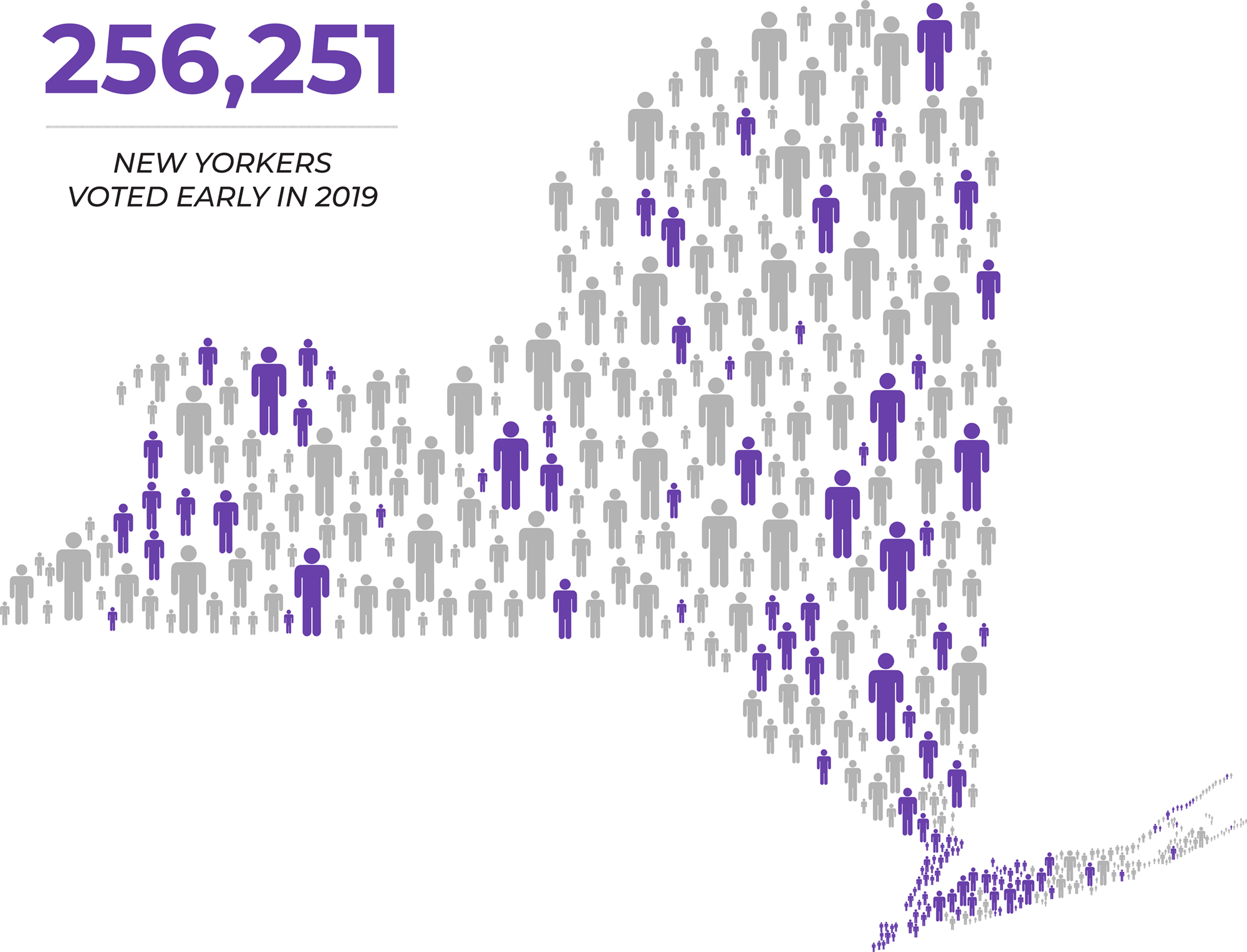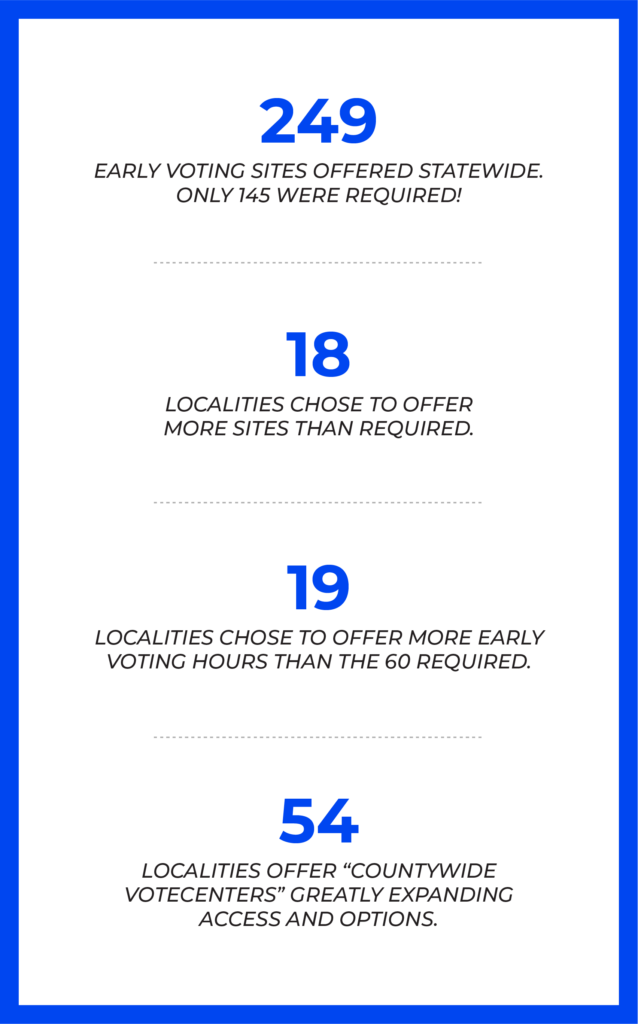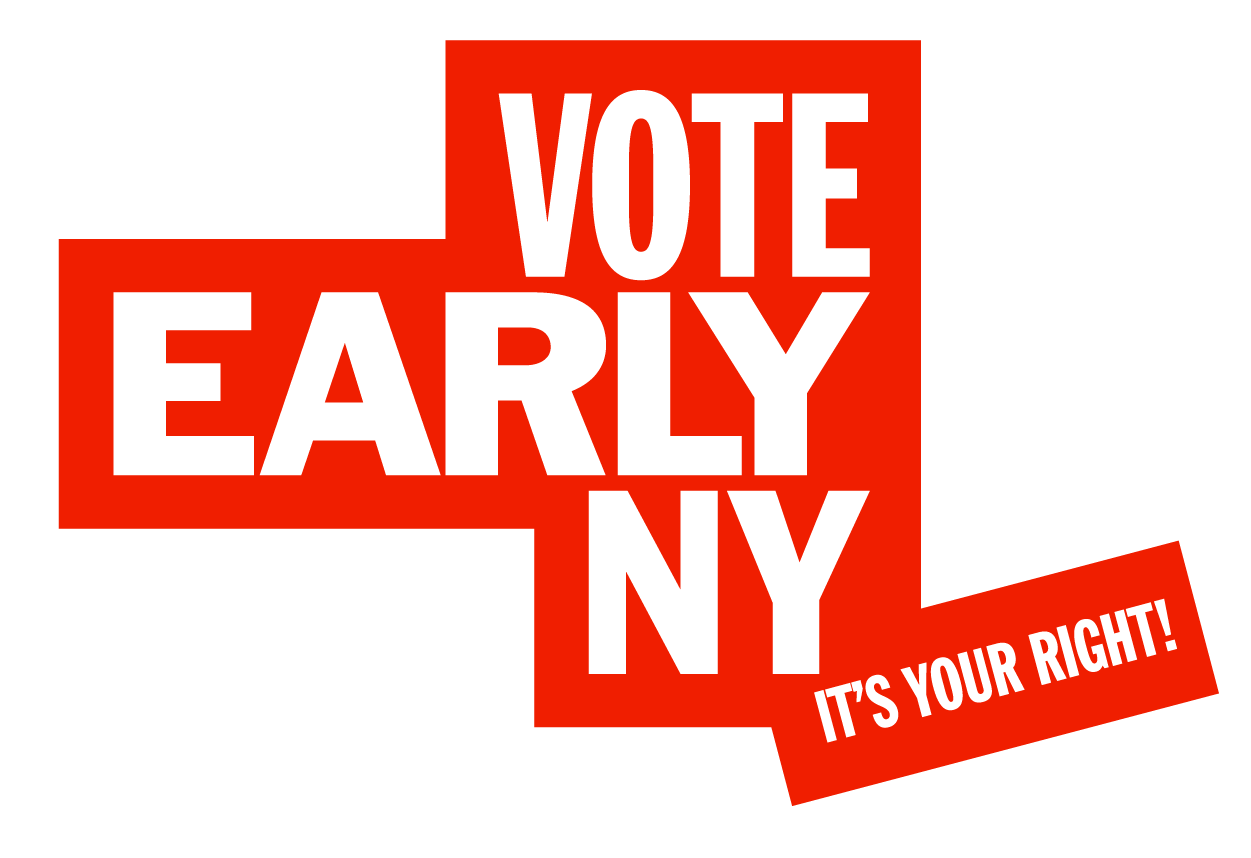Early Voting Fast Facts

- 256,251 New Yorkers voted early in 2019, including 60,110 in New York City. Unofficial 2019 turnout Statewide was up 44.69% compared to 2015.
- “The six counties with the highest early voting turnout percentages differ in size, but they had one thing in common: They opted to have more early voting centers than the law requires.” (AuburnPub)
- Sunday before Election Day proved to be the most popular early voting day, with 43,614 of all early voters (17.02%) casting their ballot on the final day to vote early (NYS BOE).
- Erie, Nassau, and Westchester combined offered more early voting sites and had 28.8% greater raw early voting turnout than all five Boroughs combined, despite having almost 3 million less registered voters.
- Erie, which offered far more sites than any county, saw 4.17% early voting turnout—more than double the state average. Nassau, which offered more than double the required early voting sites had the largest raw early voting turnout in the state.
- ~21% of 2019 Onondaga County early voters were registered but did not turn out to vote in 2017 or 2018 (NYPIRG).
- Onondaga County Early Voters by age:
-
- 47% were aged 65+; 11% were between ages 18 and 40 (NYPIRG).
- Total 2019 NYC turnout was 14%, which is considerably higher than the 6.63% of NYCers who turned out in 2015 (NYS BOE).
2019 Program Details

- 34 counties offered only a single early voting site. Based on 2019 League survey responses early voters in many of these counties reported having to drive an hour or more to get to the sole early voting site (LWV NYS).
- The law required a minimum of 145 early voting sites statewide based on population, but counties large and small, urban and rural offered voters 249 sites. 18 localities offered more sites than the minimum required by law!
- Statewide Early Voting Access Leaders Include:
-
- Erie, required to have 7 sites, deployed 37 votecenters (for 69 hours)
- Nassau, required to have 7 sites, deployed 15 votecenters (for 75 hours)
- Ulster, required to have 2 sites, deployed 7 votecenters (for 60 hours)
- Early voters in 54 of 62 counties were permitted to use any votecenter in their county as the law intends, greatly expanding access and options.
-
- Voters in NYC, Westchester, Albany, and Orange were assigned sites.
- Although each locality offered more sites than required, assigned sites are a major restriction on voter access and convenience.
- Early Vote siting remains a challenge. Whenever possible, NYS law directs localities to designate voting sites in State- or locality-funded facilities or those receiving a tax benefit. Would private sites be more convenient to the public? Maybe!
-
- The greater footprint required for early voting makes siting in traditional facilities less feasible. In 2020, there are at least 27 days of early voting.
- According to the NYS League research, 35% of early voting sites (86/249 sites) lacked access to public transportation. Concern about this deficiency was reported by early voters in The Bronx, Dutchess, Fulton, Putnam, Saratoga, Suffolk, Rensselaer, Monroe, and Ulster.
- $24.7 Million in State Funding. The NYS 2019-20 FY budget included two early voting grant programs.
-
- $14.7M Capital Grant for electronic poll books, on-demand ballot printer systems, and cybersecurity. $700K went to state testing and cybersecurity; $15,000/early voting site; Remainder to localities based on voter enrollment.
- $10M Aid to Localities Grant for local operations, staff, and implementation.
- The budget actually reduced State Board Operations funding by $1,197,000!
- Adopting new voting technology comes with increased energy and connectivity demands. To accomodate electronic poll books and on-demand ballot printers, New York City deployed 49 gas generators to supplement electricity at 80% of early voting sites Citywide, as did Livingston. Nassau worked with a telecom company to boost signal strength near early voting sites.
- 51 of 62 NYS counties adopted electronic poll books for 2019 early voting, streamlining and modernizing voter check-in and facilitating secure and convenient countywide votecenters.
Abuse of Discretion by Local Boards
- Rensselaer neglected to place an early voting site in their most populous town of Troy (pop. 49,374). 30% of Rensselaer county residents don’t drive and 70% of those residents live in Troy. The towns where early voting sites were placed, Brunswick and Schodack, have populations of 12,778 and 13,151 respectively. (VoteEarlyNY; NYCLU).
-
- Local media documented the major barrier to access this presents for Troy residents attempting to vote early via public transportation (News13).
- Suffolk (with 1,046,712 registered voters) deployed only one votecenter in each of the county’s 10 towns, despite dramatic disparities in town population, economic and racial composition. This meant Brookhaven (with nearly 500,000 residents) had a single site, as did Shelter Island (fewer than 2,500 residents). The plan was inequitable on its face.
-
- SUNY Stonybrook (student pop. 26,814) documented the major barrier to access this presents for campus residents attempting to vote early via public transportation (Watch their 3-hour journey here).
- Manhattan (NYC BOE) deployed only 9 early voting sites for more than 1.18 Million voters (roughly one assigned site per 131,270 voters). That’s more than DOUBLE the ratio of voters per site prescribed by the law, rendering Manhattan the most underserved locality for early voting access in the City and the State.
-
- Apart from Citywide disparities, Manhattan’s siting plan was inequitable within the Borough; In white neighborhoods, the average distance to an early voting site was ~7 blocks. For low-income Hispanic neighborhoods, the average distance was ~20 blocks. (NYCLU)
- By contrast, Erie County had a ratio of roughly one site per 17,192 voters, and Erie voters could visit ANY of the sites in the county.
